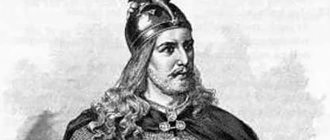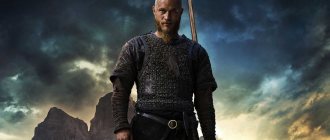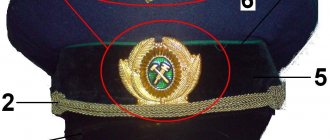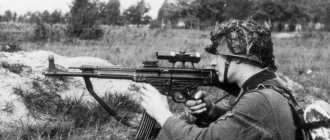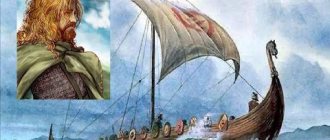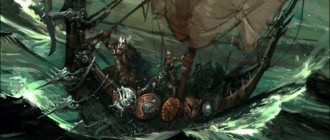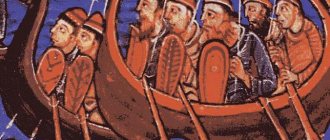The lives and deeds of famous historical figures of different nations are often surrounded by myths. A significant role in this is played by the lack of chronicles, folk tales, and legends. Often, people who really existed become collective images of both their contemporaries and earlier generations.
Ragnar Lodbrok is one of these characters, his life is associated with the 9th century. Since the Vikings did not keep records, the true existence of this person remains in question. Most information about him is drawn from legends and sagas, which are not reliable.
Despite this, it is Ragnar “Leather Pants” who is credited with the significant campaigns that are reflected in Western European chronicles. The main emphasis is on the capture of Paris and the Viking campaigns in England.
Ragnar's bloodline
There are no images of Ragnar made by contemporaries, so there is nothing to compare his image from the series with.
In the absence of reliable sources confirming the existence and history of Ragnar Lothbrok, there is no information about his pedigree. The generally accepted version is that he is called the son of Sigurd the Ring.
According to legends, Ragnar's family belongs to the Yngling dynasty, descended from the Scandinavian god of sunlight, Frey. The latter was considered the grandson of Odin and the most peace-loving god, who became the ancestor of the Swedish and Norwegian kings.
Storm's research into the historicity of Ragnar indicates that he may not have been a Danish king by birth. The fact is that names were included in the list of Danish kings already in the 12th century. Much of the information was based on Frankish chronicles. It is possible that the Frankish chroniclers attributed Ragnar to the Danish kings precisely for his leadership of the Viking army and the capture of Paris.
In this context, Ragnar could only be the leader of one of the Viking raiding groups that raided the coasts. Authority and luck helped him assemble a significant fleet, with which he made major campaigns. The actions of earlier leaders and kings can also be attributed to the image of Ragnar. The popular series also touches on this version of the origin of Lodbrok.
In this context, the question of Ragnar's real existence remains open. Two evidences of his life are given - an attack on Paris and death in Northumbria. At the same time, it is not excluded that they could relate to different personalities, for whom Ragnar became a collective image of the legendary warrior and hero of the Danes.
Live in such a way that people pray to God for protection from you
Ragnar Lothbrok, like most Vikings, was not known for his mercy. His raids had monstrous results - the king’s squad, which began to empty the next settlement of food and valuables, did not spare anyone.
During the campaign against Paris, Lodbrok, as a warning to his enemies, hanged more than a hundred enemy soldiers on the banks of the Seine, after which he began to burn the houses of local peasants and even churches.
In general, the attitude of the pagans towards Christianity was indifferent; often the Vikings themselves converted to the new religion, and sometimes more than once. But if some temple stood in their way, the church servants faced an unenviable fate.
Researchers believe that the famous prayer “De furore Normannorum libera nos, Domine” (Save, God, from the fury of the Norman) appeared precisely during the raids of Ragnar Lothbrok on Europe.
Legends of the origin of the nickname "Lodbrok"
There are two legends that explain the nickname Lodbrok. Both are associated with the translation of this word as “Leather pants”. According to the first version, Ragnar received this nickname as a child, falling into a pit with poisonous snakes. He survived thanks to his leather pants, which protected him from bites.
Another version tells of leather pants made by Ragnar's first wife, Lagertha. According to legend, she gave them to her husband as an amulet that could protect him in battle. It is believed that the tough hide actually protected it from glancing wounds, which is how it got its nickname.
There are versions associated with misunderstanding and translation of the word Lodbrok. According to one of them, the nickname referred to the dark green color of the pants worn by Ragnar and many other Vikings. This version can be explained by the collective image of the king, who thus personified the Scandinavians.
There is a variant translation of the nickname associated with a distortion of the name of the river Lodbrik, translated as “stream of hatred.” Such a version seems unlikely in the absence of a legend why Ragnar received his nickname after the name of the river.
Another version attributes Icelandic roots to the nickname Lodbrok. In this case, it comes from leodbroga, which translates as “scaring people.” This legend is due to the fact that Icelandic storytellers played a large role in describing the life and campaigns of Ragnar, collecting and recording legends about him.
Another version of the origin, close to historicity, connects Ragnar with his banner. It depicted one of Odin's ravens. In this case, Lodbrok can mean “fate-banner” or “banner of fate” (lod - fate, brog - banner).
Quotes
“I want something that has no price in gold, but is priceless to me. I want to be baptized."
“Power is always dangerous. It attracts the worst and corrupts the best. I never asked for power. Power is given only to those who are willing to bend down to receive it.”
“Man is the master of his own destiny, not the gods. The gods are created by men to give answers that they themselves are too afraid to accept.”
“My heart believes that he will not betray me, there is no reason for that.
- Do you really need a reason for betrayal? You should always be prepared for the worst, even from your loved ones, then you can avoid many disappointments.”
Fact or Fiction about Brother Rollo
Statue of Rollo in Falaise, Normandy
Rollo (Rollon) is a real person who lived approximately 860-932. He became the first Duke of Normandy under the name Robert I, considered the founder of the Norman dynasty and the ancestor of William the Conqueror.
Given Ragnar's indirect historicity, there is no evidence to suggest that Lodbrok was related to Roll. Taking into account the customs of Scandinavian families, which were distinguished by large families, Ragnar could have had brothers with a similar name. However, his role was not significantly reflected in tales and legends.
There is no reason to connect Ragnar and Rollon in the same generation. The difference between them is several decades, which excludes fraternal ties. Family ties between them are also unlikely; in most cases, such options are fictions connecting real dynasties with legends and famous heroes.
General overview
The emphasis in the name Ragnar falls on the second syllable. The colors suitable for wearers are blue, purple and violet. The patron planet of people with this name is Jupiter. The most suitable objects that give strength are composed of tin and zinc. Thursday is considered the lucky day of the week. Pisces and Sagittarius are the zodiac signs that bring good luck. Talismans - amber, sugulite, pyrite, chrysoprase, dolomite, tsavorite, black tourmaline, ruby.
Ragnar will have good relationships with women named Nika, Arina, Christina, Irina, Yulia, Angelina, Marina, Varvara, Emilia, Alice, Amina, Anastasia, Vera, Nadezhda or the purely Scandinavian Lagertha, Chloe, Aivenda, Helga. This name is used not only in northern countries. Although its form changes, the meaning of the name Ragnar remains the same. But it is quite difficult to identify this name. Many will not be able to guess that Ranchero, Rainer, Rainer, Ranier, Rainer, Rainerio are all the same Ragnar.
Wives and children
Despite debates about the reality of Ragnar as a historical figure, information about his wives and children is quite detailed. The same legends played a significant role in this matter. Some say that Ragnar even dressed in women's clothing to meet one woman. This is most likely a fiction, emphasizing his love of love, since not a single Viking would stain himself with such shame.
According to legend, Ragnar was married three times. The first wife is Lagertha, one of the warriors. It was she, according to legend, who sewed leather pants for her husband, from which he received his nickname. To take her as his wife, Ragnar had to fight a wolf and a bear. According to some sources, he had to defeat her herself. Lagertha gave birth to a son, Fridleive, and two daughters, whose names are unknown.
In his second marriage, Ragnar married Tora, the daughter of Earl of Gotland Erraudr. According to legend, a Viking defeated a snake for her hand. From her were born:
- Eirik, who in some sources is considered Erik Wederhutt;
- Agnar;
- daughter, whose name remains unknown.
For the third time, Ragnar married Princess Aslaug, daughter of the legendary King Sigurd, who killed the dragon Fafnir. The historicity of Aslaug also remains in question; her other names are also known - Aslaug, Kraka, Krab. From this marriage were born:
- Bjorn Ironside;
- Sigurd Snake-Eyes;
- Hvitserk;
- Ivar the Boneless.
Although all of Ragnar's sons later became jarls, it was the children from his third marriage who gained greater fame. This is largely due to revenge for the death of their father and their campaign in England.
Ragnar had many children out of wedlock. Such names as Ubba, Harald, Halfdan, Ulv, Ragnhild are known. Many of them also took part in the campaign against the Anglo-Saxon kingdoms.
In contemporary art
Many artists turned to the Scandinavian epic. Ragnar Lothbrok is a popular character in books and feature films.
In literature
The legendary Scandinavian warrior became a character in the following literary works:
- Harry Harrison "The Hammer and the Cross";
- Edison Marshall "Viking";
- Jack London "Interstellar Wanderer";
- Maria Semyonova “Two Kings”, “Sign of the Falcon”, “Swan Road”.
To the cinema
The cinema also did not ignore the colorful figure mentioned in ancient legends. In 1958, the film “Vikings” was shot, in which the main role was played by actor Ernest Borgnine. In 2013, the series “Vikings” was released on world screens, making Australian actor Travis Fimmel famous. Exciting events have captivated viewers to their screens for 5 seasons.
Travis Fimmel in the TV series Vikings
Despite the fact that the reality of the existence of Ragnar Leather Pants has not been proven, the fame of him has lived on for many centuries. Perhaps his image is a collective one, reflecting the personalities of several historical figures who had a strong influence on the history of Northern Europe.
Subscribe to the Military Observer channel in Yandex.Zen
News Media2
Ragnar's Great March into the Lands of the Franks
The Viking campaigns against France and England, Ragnar's raids belong to the late period, marked with a dotted line.
Viking campaigns on the coasts of European states were carried out regularly. Single ships and entire groups carried out raids, plundering villages and monasteries. Legends show that Ragnar Lothbrok was especially successful in these raids, committing the most daring adventures.
With such fame, Ragnar was able to gather significant forces, conducting increasingly large military operations. According to legend, the desire to remain in history as the greatest warrior and commander prompted him to take his main campaign - the capture of Paris.
The French army was considered one of the strongest in Europe. However, internecine wars in the first half of the 9th century weakened the kingdom. Three contenders fought for the throne, who did not disdain to attract detachments of Scandinavians to their side.
Under these conditions, Viking raids on the French coast became more and more daring. In 842, Hasting's army ravaged the Loire Valley, and also, with the help of the rebellious Count Lambert II, captured Nantes, devastating the city. Having strengthened his positions on the coast, he could constantly receive reinforcements.
Hasting's personality is also considered semi-legendary in many ways. Many sources make him an associate of Ragnar. However, Lodbrok's raid did not take place until 845. Having gathered an army of almost 5,000 people, he landed at the mouth of the Seine on 120 ships.
The ruler of the Franks, Charles II the Bald, having gathered an army, divided it into two parts, leaving it on both banks of the Seine. Taking advantage of this, Ragnar quickly defeated the smaller part, publicly executing 111 prisoners. The next day, March 28, Easter Sunday, Ragnar entered Paris, sacking the city.
Despite certain advantages and successes, the situation on both sides turned out to be difficult. Plague began in the ranks of the Vikings, while they were 300 km from the sea, in a devastated city next to the enemy army.
Charles the Bald himself was surrounded by enemies on all sides. Rebellious provinces, the threat of war with Brittany, hostile relations with neighboring states - all this did not allow for a siege and delaying time. In this situation, the huge ransom of 7,000 pounds in silver became a compromise for both sides.
In exchange for the ransom, Ragnar promised not to destroy the city. He kept his word, but on the way back he destroyed the villages he came across. Unlike many other raid leaders, he sought to avoid destruction and killing civilians, limiting himself to robbery. He explained this by the opportunity to return in a few years and plunder the village again.
Passion
The young man is interested in elegance and harmony in absolutely all manifestations, so Ragnar makes an effort to surround himself with this. Follows the usual regime, and its failure is unpleasant, loves to be a leader, can turn an enemy into a comrade, outwitting him. He has a large number of friends, but the man has few enemies. Constantly ready to reconcile people, awaken positive emotions in negatively minded others.
Main versions of Lodbrok's death
19th century engraving depicting the death of Ragnar
The death of Ragnar Lothbrok is one of the few aspects that has indirect historical confirmation. However, versions of how he was executed also differ. In any case, the death of the legendary leader is associated with subsequent campaigns in Northumbria and the Great Pagan Army.
Historians associate the intensification of raids on the English coast with a successful campaign in France. 6 years after the sack of Paris, Lodbrok again launched raids, achieving varying degrees of success at different times. In 862, Charles the Bald strengthened the fortifications of cities and rivers, which made it difficult for the Vikings to advance. At the same time, monasteries began to be built in the interior of the country, which deprived the Scandinavians of prey
In this context, raids were increasingly organized on the English coast. During one of these expeditions in 865, Ragnar's ship ran aground, the detachment was killed, and the leader was captured. By order of King Ella II, Lodbrok was put in a pit with poisonous snakes.
There are other versions of Ragnar's death. According to one of them, the Viking fleet was caught in a storm, and the remnants that found themselves on the coast were finished off by English troops. Another legend says that Lodbrok set out on one ship for prey, hoping for his reputation and glory. Once captured, he continued to threaten the British, demanding release and ransom.
Will there be a season 6 of Vikings?
There is good news for fans! Back in 2022, a popular television network in the US announced this.
Executive producer Eli Lehrer said: “Vikings Season 6 will feature brutal battle scenes between Rognar Lothbrok and the Great Army of China. And his sons will continue to explore and conquer the world. It is planned to film about 40 more episodes of the historical series “Vikings”.
Filming for season 6 of the series has already begun on the set in Ireland. And at the end of this year, viewers will see season 5 of the series “Vikings.”
Children's revenge for the death of their father
Drawing of a Viking warship
According to legend, Ragnar said before his death: “My piglets will grunt when they find out about the death of the old boar.” The reliability of these words remains in doubt, however, the invasion of the sons of Lodbrok became known as the Great Pagan (Danish) Army.
In 866-867, an army of thousands of Vikings led by Ivar the Boneless, Bjorn Ironside, Halfdan and other Ragnarsons invaded England. Within a few years, Northumbria, Mercia and a number of eastern lands were plundered. King Ella II was brutally tortured to death.
During this campaign, many Scandinavians arrived to settle. The Vikings had strongholds and received reinforcements, which made it possible to develop the offensive. Only in 878 did Alfred of Wessex, nicknamed “The Great,” manage to win a decisive victory at Ethandun and, on its basis, conclude the Treaty of Wedmore. The Viking invasions in England ceased, but their raids resumed in mainland Europe.
Characteristics of the inner world
Ragnar is characterized by natural creation and creative endeavors. There is always a noticeable manifestation of talent in some area. A person is drawn to what looks catchy and extraordinary, actively looks for talents in himself, and develops his abilities. He strives to make the people around him feel good. In search of himself, he spares no effort and opportunities, because of this, others do not understand Ragnar.
It is worth noting the influence of the meaning of the name Ragnar for a boy: in early childhood, a craving for creativity, leadership qualities, and a desire to achieve everything on one’s own, without anyone’s help, are immediately noticeable.
In general, children with this name are calm in character, attract people to themselves and control them, but modesty often hinders them. As a rule, Ragnars are very sociable. If there are strong emotions for a person, he can feel and understand everything. In most cases he becomes an ideal husband.
How love shows
A person with this name needs to fall in love, but often does not realize it. Treats her partner with tenderness, attention, and is not ashamed to show love. There is insecurity, timidity, and suspicion in his behavior.
Ragnar is a very sensitive, touchy and often irritable person. Being far from their partner, they often feel useless and insecure. Therefore, they have to look for a person who does not get tired of obsession, in which case the relationship becomes long-lasting and harmonious.


